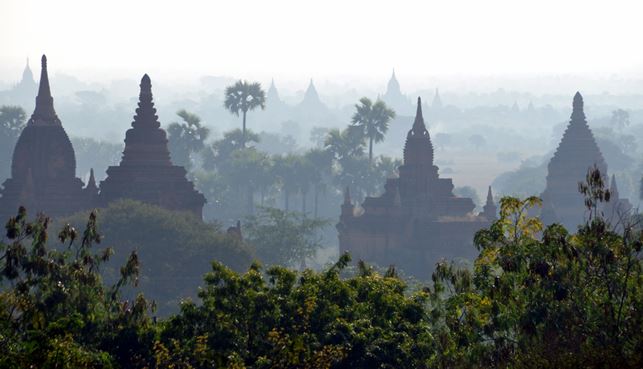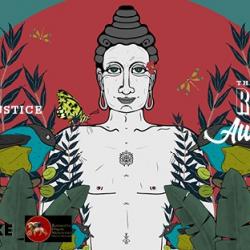
This Thursday marks the 25th anniversary of the 8/8/88 uprising in Burma, which will hopefully spur some much needed discussion about the situation in the country (officially renamed Myanmar by the military junta in 1989, but still called Burma by those who deny the legitimacy of that government).
Three articles have already popped up in the last few days that deserve mention, if only for the varying perspectives in them – all dealing specifically with recent Buddhist-Muslim violence. The three perspectives are, roughly, that of a Conservative Christian, a journalist, and an academic.
The first of these, Understanding Islam: Buddhist common sense vs Western nonsense by Raymond Ibrahim reiterates some of the ‘peaceful happy Burma shattered by Muslims’ myth that I mentioned in a recent post. Ibrahim asks, “If indigenous Buddhists are simply becoming nationalistic radicals, as Fuller suggests, how come they are only attacking Muslims, not Christians and Hindus?” The answer is, when placed in the larger historical context, that they have attacked both Hindus and Christians (and fellow Buddhists and others). Following independence in 1947, thousands of Indians who had migrated under British rule were forced out of Burma. Even before then, the rise of Buddhist Nationalists sought to unify the nation under one religion. As Donald Seekins writes:
The British also encouraged the immigration of people from the Indian subcontinent, most of whom were Hindus or Muslims, greatly increasing the size of these religious minorities, especially in Lower Burma. This contributed to violent communal clashes during the 1930s between Burmese Buddhists and Hindu or Muslim Indians. Burma’s status as a secular state continued after it became independent in 1948, but in August 1961, with the backing of Prime Minister U Nu, parliament passed a constitutional amendment making Buddhism the official religion. (p.378)
The law making Buddhism a state religion was quickly rescinded, though some would consider Buddhism to have been maintained as a de facto state religion ever since. Along with ongoing conflicts between the central government and the Kachin (a mostly Christian ethnic group), Christians in general have faced discrimination:
In many ethnic minority areas, especially where Karens, Kachins, and Chins live, the church, brought by missionaries in the 19th century, remains the core of educational, social, and spiritual life. But Christian activities are also limited by the state, which despite the lack of a constitutional provision making Buddhism the official religion has tended to act on the old notion “to be Burmese is to be Buddhist.” In other words, non-Buddhists are a “Them” juxtaposed to a Buddhist “Us.” (Seekins, p.11)
The journalist, Dominic Faulder’s article, called “Lessons of ‘88,” provides a somber reflection on the slow pace of democratic progress in the nation after the demonstrations in that year:
The failed 8/8/88 rebellion lasted nearly six weeks. It followed 26 years of bizarre and xenophobic misrule by strongman Gen Ne Win. Late that year, when there was still some lingering hope of change, an old Asia hand predicted it would take at least as long to put right the damage the old general had wrought. As we look back from 25 years on, that prediction has turned out to be grimly true. A quarter century down the road, can any lessons be learned from the failures of Myanmar’s pro-democracy movement in 1988?
This failure despite great optimism was an echo of the post war and independence period in Burma, when the nation was not only extraordinarily rich in mineral and lumber resources, but was also the world’s largest exporter of rice. At that time, countless factors including ethnic animosities and capitalist vs communist ideologies ushered forth one atrocity after another, including the murder of Aung San, the father of modern-day Burma and father of Aung San Suu Kyi. Faulder continues (with echoes of recent Middle East events on his mind):
One of the great myths propagated by the West and its media is that democracy produces better governments. In recent decades, one need look no further than Australia, Cambodia, Egypt, Greece, Iran, Italy, Thailand, the United Kingdom, the United States or Venezuela to see that perfectly free and fair elections can produce perfectly rotten governments—which is exactly why elections are so valuable. The great gift of democracy is not the guarantee of electing a better government; it is the power it gives the electorate to vote out a bad one in a peaceful, orderly manner. The Catch 22, however, is that a bad government will often not allow itself to be dismissed in a decent and transparent process. Indeed, SLORC’s disinclination to honor the 1990 election result is one of the best examples of this.
Faulder concludes with a mixture of hope and caution:
It is not saying much at all, but at the end of the day this is the most democratic government Myanmar has had in over five decades. There is no mileage in lamenting that all this did not get going sooner. Maybe the greatest lesson of 8/8/88 is how easy it is to have all the moral high ground yet go nowhere.
Thus we might simply be in the midst of 1988 and 1990, when democratic elections were simply ignored, all over again. I think there are good signs that we are not – including the rise of the internet and the closing of the office of censorship – but the problem of divergent ethnicities and ideologies continues. David Brown, a Political Science professor in Australia, wrote in 1994 that:
The confrontational and protracted nature of the disputes can be traced in part to military stalemate, but there is also a more fundamental reason. They have come to be perceived by all parties, not as negotiable political issues, but rather as clashes between absolutist and irreconcilable ideologies: the imperative of state nationalism confronting the imperative of ethnic nationalism. Explanation of the rebellions must be sought, therefore, in examination of the processes have which generated such antithetical perceptions of state and ethnic nationalisms. (p.23)
It is not clear to me that much in this area has changed in the last 20 years. When I visited the Shan State in 2011, a shopkeeper hushedly waved me to a desk where he pulled out hidden copies of then-banned books celebrating Shan culture and identity. Pointing to the word “Shan” on the cover of one, he said “This is my country.”*
These are the ‘deeper issues’ I mentioned in my last post on the topic. The ethnic differences have largely involved minorities seeking autonomy or at least fair representation in national politics. It is worth noting that in the power vacuum left by the British, the strongest cohesive unit of power -against all others- was the AFPFL, which after 1948, “developed as an essentially Burman ethnicnationalist movement which articulated the goal of Burmese independence in the name of a defence of Burman ethnic language and culture, and of the Buddhist religion, portraying the independent Burmese state as rightful successor to the Burman dynasties of the past. Thus the AFPFL mission which went to London under Aung San’s leadership in 1946 to demand independence consisted entirely of Burmans, and in the early 1950s all of its chief officers, under the Presidency of U Nu, were Burmans” (Brown, p.31).
The final article features the academic Michael Jerryson, who is largely responsible for the language of “Buddhist violence” in academic and popular discussion in the last ten years. There he is asked:
Aren’t ethnic rather than religious reasons more to blame for the conflicts we’ve seen in many predominantly Buddhist nations?
[he answers:] There are a range of diverse factors that contribute to the instances of what is seen as religious violence in places like Thailand, Sri Lanka and Myanmar. But then again, religious teachings and forms of Buddhist nationalism have been observed greatly influencing this violence too. Monks who should be peacemaking (or so we assume, especially in the West) are seen aggravating or causing conflict. This anomaly led me to start looking at this long history of Buddhist warfare. But I’m just arguing that when religion is injected into the conflict, even if it’s Buddhism, it changes the parameters of such conflict in many ways.
And concerning U Wirathu specifically he adds:
There would be many who’d say Wirathu is an extremist and not the true face of Buddhism, which would be the case with religious fundamentalism anywhere. Yet as a scholar it is not my place to judge that, like say the Roman Catholic Church can do in some Christian contexts. My job is to study and document and point to what is ignored. It’s not about highlighting violence in Buddhism for its own sake, but to make sure it’s included in the discourse. Because it’s there.
Fundamentalism in particular is a sensitive subject, as I found out in May when I wrote about Buddhism, Islam and Fundamentalism following the Woolwich murder and subsequent hate crimes against Muslims here in England. Returning to Jerryson’s first response, however, there is something of a conspiracy theory circulating that the junta is using Buddhist nationalism (which would unite, at least nominally the Burman, Shan, and Karen ethnic groups) against a common, fabricated enemy, the Muslims, thus distracting everyone from their decades-long goals of autonomy or fair representation. Just as the weak democratic government facing internal strife had to turn over power to the military as a caretaker from 1958-1960 – which then helped legitimate the 1962 takeover – a similarly democratic facade could be forced to crumble if current problems get out of hand.
It’s difficult to say just how much the junta is orchestrating violence (though it’s painfully clear that they are woefully neglecting Muslim victims), but the depth of this conflict and the ongoing nature of others are why I wrote about “the fractious nature of Burma today and the fragility of its movement toward democracy” last time. It would be macabre to suggest that India had it easy in the wake of the British colonial exit: one massive bloodletting and migration under two separate nations instead of a heavy military fist holding opposing people together against their will. Of course that didn’t solve everything: two became three in 1971, contested areas remain, ideological rebellions have not ceased, and religious violence, too, has led to many tragedies: against Sikhs, against Muslims, against Christians, against Hindus…
If that’s what multi-ethnic/multi-religious post-Colonial democracy looks like (and need i bring up the Middle East?), perhaps we could only be so lucky to see the junta reassert itself, saving us from witnessing the unraveling of modern Burma.
* I believe the books were “The Shan of Burma: Memoirs of a Shan Exile” and “Twilight Over Burma: My Life as a Shan Princess.”
For scholarship on the topic cited here, see:
David Brown, The State and Ethnic Politics in South-East Asia and
Donald Seekins, Historical Dictionary of Burma (Myanmar)
* News update (Aug 5), via the US Campaign for Burma: A call for federalism, equal representation, and a new Constitution was issued on August 2 by the United Nationalities Federal Council, which gathered together ethnic and resistance groups last week in Chiang Mai to develop a joint strategy for reaching a political solution with the Burmese government. The key positions and decisions are as follows (read the full document here .pdf):
(a) To form the present Union of Burma/Myanmar into a Federal Union of national states and nationalities
states, having national equality and self-determination;
(b) To practice federal democracy in this Federal Union;
(c) To form Federal Union Defense Forces that will defend the Federal Union from external dangers;
(d) The current 2008 Constitution practiced by U Thein Sein government is not accepted, as it is devoid of
democratic essence and not in accordance with the principles of federalism. A new Constitution based
on genuine federal principles will be drafted and promoted for practice;
(e) The UNFC and UNA will lead in drafting the new Constitution, and a drafting committee consisting of
representatives from the democratic forces, women organizations, youth organizations, CBOs and
other organizations will be formed, as part of the realization of the aim.
(f) In political dialogue and negotiation, the 6-point political program, laid down by the Ethnic
Nationality Conference held in September 2012, will be followed. In political dialogue and
negotiation, all the resistance organizations are to be represented as a bloc, and not individually.











